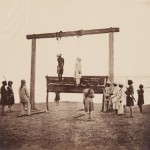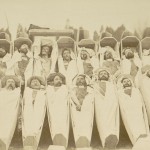
Back in November the exhibition WAR/PHOTOGRAPHY: Images of Armed Conflict and Its Aftermath opened at its fourth and final venue, the Brooklyn Museum. This exhibition, which I curated with Anne Tucker and Will Michels in my former role in the photography department at the Museum of Fine Arts, Houston, featured over 400 photographic objects dating from 1848 to 2012, including a number of photographs from the Harry Ransom Center’s collections. Our curatorial mission was neither to tell a history of war illustrated by photography nor to present a series on singular photographers. Instead, we hoped to bring together a selection of objects that highlighted the intersections between war and photography.
Photographs from the Ransom Center collections were included throughout the exhibition, enriching the thematic sections that explored daily routine, shell shock, and dissemination, as well as battlefield burial and death. The Gernsheim collection yielded a chilling 1871 print of communards in coffins, an image likely used to discourage further unrest in the streets of Paris, as well as Roger Fenton’s iconic and controversial 1855 photograph The Valley of the Shadow of Death from the Crimean War.
A Ransom Center fellowship funded by the Andrew W. Mellon Foundation Research Fellowship Endowment enabled curator Anne Tucker to spend weeks going through box after box of the Ransom Center’s prints, lantern slides, and stereographs. While in the reading room, she could compare the croppings of multiple photographs of Captain Ike Fenton and the U.S. Marines during the Korean War by David Douglas Duncan and share her findings. She also surveyed the collection of prints made at the height of the civil war in El Salvador by 30 international photographers, including Donna DeCesare and Harry Mattison.
The New York Journal- American photo morgue provided one of my favorite photographs in the exhibition. It is a small print from 1918 of a carrier pigeon being released from a tank on the Western Front. The image itself references one of the means of communication (pigeon transport) that is often associated with World War I, but it is also important as a photographic object because it carries the marks and highlights of an editor’s pencil, readying the print for reproduction and the image for dissemination.
Please click on the thumbnails below to view larger images.










